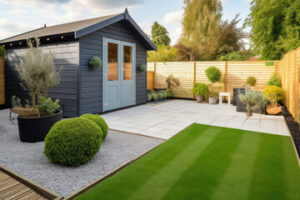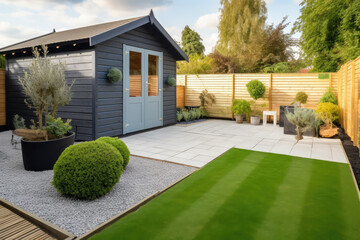Artificial Grass Colorado Springs are now commonplace at many sporting facilities and in residential yards. It’s non-toxic, pet-friendly, and kid-friendly nylon or plastic materials.
Darker synthetic lawns can attract more sunlight and heat, which can cause them to deteriorate faster than lighter ones. However, there are several ways to keep the turf cool.
Artificial grass is a synthetic material that can be made to look like real grass, and it’s available in different blade lengths, textures, and shades of green. It’s aesthetically pleasing, requires little maintenance, and can be used in gardens and lawns. It also saves water, reducing the risk of flooding and droughts. It is also a sustainable and eco-friendly alternative to natural grass. However, it must be cleaned and sanitized regularly to prevent the growth of bacteria and other contaminants.
It is made from high-quality raw materials and a rigorous manufacturing process, so it’s generally very durable. It can withstand heavy foot traffic, kids playing, dogs digging, and cat scratching, and it doesn’t fade or fray. In addition, it’s non-toxic and made from kid-friendly nylon or plastic materials that are safe for pets.
Synthetic turf is also ideal for shaded areas, where sunlight can kill natural grass. In addition, it does not need to be mowed or fertilized, which can help to reduce the use of herbicides and pesticides. It is also easier to maintain than real grass, which can be difficult to care for in the winter. It’s not totally maintenance free, however, and it needs to be weeded periodically. It’s best to use a weed membrane and a good quality weed killer to keep your fake lawn weed-free.
While it may be easy to install artificial grass, you should pay heed to all of the points that are listed below. First, it’s important to know that the sand or crumb rubber used in fake grass can make children and pets sick, so you should always opt for non-toxic synthetic turf. Another thing to keep in mind is that a well-made fake grass lawn can be a great investment, but it’s not cheap, and it may require professional installation. However, a well-made turf can often pay for itself in just a few years by saving on water, fertilizer and lawnmower costs. It can also boost the resale value of your home.
Appearance
Artificial grass has come a long way since it first gained prominence in Association Football in 1966 at the Astrodome. Back then, it was referred to as ChemGrass or AstroTurf and looked much like low-pile carpet over concrete. Today, however, the soft plastic surface looks and feels almost identical to natural grass. In fact, it’s often hard to tell the difference. Whether you want to replace your front or backyard lawn, you can choose from a variety of colors and styles to suit your needs and taste.
When choosing a synthetic turf, consider the face weight and infill. Face weight refers to how many ounces of fiber per square yard a type of turf has. A higher face weight indicates a better quality, but you should also look for infill that will help the synthetic grass stand up to the elements. Infill typically consists of crumb rubber or recycled plastics that help the synthetic grass withstand the weight of players, equipment, and other objects.
In addition to infill, it’s important to check how well the turf drains. A good drainage system will prevent water pools and odors. It will also keep the turf cool by dissipating heat, so you can enjoy the outdoors without overheating.
Another important factor to consider when choosing a synthetic grass is the yarn that it’s made of. There are three main types of synthetic grass yarn: polyethylene, polypropylene, and nylon. Polyethylene is the most common choice because it offers a great balance between durability and aesthetics. Polypropylene is not as durable as nylon, but it’s a good choice for landscaping because it’s extremely flexible and resists stretching.
Nylon is the most expensive type of synthetic grass yarn, but it’s also the strongest and best-looking. It mimics the color and texture of specific species of grass, and it’s highly resistant to fading. It’s often used in putting greens and as a thatch layer on landscape grasses.
When shopping for synthetic grass, it’s also a good idea to check out local laws before purchasing. Some municipalities have regulations about the use of synthetic grass, and some require homeowners to have it removed if they can’t afford to maintain it properly.
Maintenance
Artificial grass, or turf as it is sometimes known, used to be reserved for mini-golf courses and sports arenas but has now become a popular option for residential lawns. Its popularity is due to a number of reasons including that it doesn’t require the use of electric or fossil fuel mowers, does not need water and can withstand heavy usage. It also requires very little maintenance and is more cost-effective than real grass.
The best way to maintain a synthetic grass garden is to keep it clean and free of weeds. To do this, you can use a mechanical brush or power broom. This tool helps to remove traffic wear prints, gets rid of flat spots and refreshes the look of the lawn to make it appear new again. It is also useful for removing large debris such as leaves and twigs that are often difficult to remove with a basic push broom.
Spills and stains are inevitable, but can be dealt with quickly by wiping them up as soon as they occur. Then, simply apply a mild cleaning solution such as a low-sud dish liquid, delicate fabric detergent or a non-chlorine bleach cleaner. You should rinse the area with water afterwards to prevent any residue.
Another essential aspect of keeping your synthetic lawn clean is removing pet waste promptly. Using a pooper scooper or a chemical such as PoopClenz will help to minimise odour and keep the area clean and safe for children and pets.
It is recommended that you hose down your synthetic lawn at least once a week lightly. This will wash away accumulated dirt and prevent weed growth. If you have a large yard, you can even buy a machine that will spray the grass with water from a nozzle at a high pressure.
Artificial lawns are resistant to bacterial growth, but neglected food remnants or pet urine can attract bacteria and create an unpleasant odour. To reduce the risk of bacterial growth, you can use a disinfectant such as vinegar or a product specifically designed to clean synthetic lawns.
Cost
Artificial grass is increasingly being used for home landscapes. It has many advantages over natural turf, including low maintenance costs and water savings. However, the cost of installing synthetic turf can be high. The price depends on the type of turf you choose and the amount you need to cover your yard. Some companies offer discounts for large orders, such as 1,000 square feet or more.
The cost of installing artificial grass varies widely. Several factors affect the price per square foot of the turf, including lawn size and shape, type of turf, base material, and weed barrier. Also, add-ons like a putting green or mow strips may increase the cost of your project. It is best to shop around and compare prices before making a purchase.
In addition to the cost of the turf itself, homeowners will need to pay for installation and other related costs. The installation cost typically ranges from $5 to $20 per square foot. A professional can install the artificial turf faster and cheaper than a homeowner. Homeowners should hire an experienced synthetic lawn professional to avoid incorrect measurements or installation that could lead to drainage issues, mildew growth, and invalid warranties.
A good quality artificial grass can last for a long time. The synthetic turf can withstand high traffic and heavy use and will look beautiful for years. It also has the advantage of being free from insects, weeds, and drought. It is also safe for children and pets. The artificial grass will also save you money on energy and water bills.
While synthetic grass is more expensive than natural turf, it pays for itself in the long run. It is also less expensive than regular lawn care, and it does not require any chemicals or fertilizers. In addition, it is easy to install and can be laid over an existing soil.
Synthetic lawns are also a great choice for commercial properties and sports fields. They can handle heavy wear and tear, and they are available in various colors and blade patterns. You can even find artificial grass with a drainage system and antibacterial sand infill.
